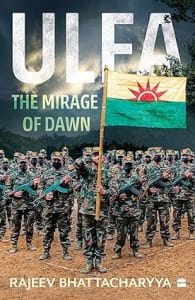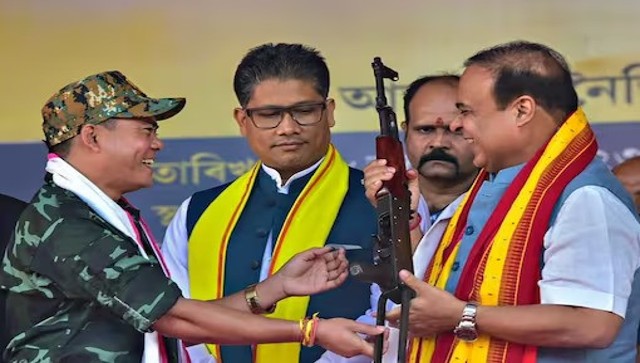Among the momentous chapters in post-Independence India were armed rebellions of diverse hues in different parts of the country including in North East. The diversity was more discernible in the North East where armed outfits with assorted aims and objectives emerged across all the states barring Sikkim. Among the prominent separatist rebel groups still active but severely weakened is the United Liberation Front of Asom (ULFA) in Assam which was banned in 1990. As a matter of fact, the insurgency in India’s North East didn’t develop abruptly and with a universal spread across the region. In 1950, the failure to deal with the serious unrest in Nagaland came with a cost and that created a permanent fissure. The process of alienation in North East fuelled the secessionist movements in North East, their manipulations were made possible with lack of proper counter-responses from the centre for addressing the core issues in the initial decades after India’s independence in 1947. Assam that had long been not part of any violent armed rebellion and in fact regarded as part of the Indian national mainstream, of late, also witnessed a very violent insurgency on the issue of influx of large scale illegal migrants from neighbouring Bangladesh and major demographic changes. After the birth of Bangladesh, the trend of such migration even grew further. Initially, it was not resisted as India had just made possible the creation of Bangladesh by defeating Pakistan—and thus the people of Bangladesh were seen as collaborators. Till Sheikh Mujibur Rahman ‘Bangabandhu’ was in power, the people of Assam didn’t resist the coming of migrants from beyond the border. After his assassination on 15th of August 1975 and the radical change in Bangladesh politics, reaction against the Bangladesh’s migrants started simmering and it took an organised turn when the emergency was lifted in India. By that time, Bangladesh entered in a radicalised phase where the Islamic order gave a ground of protest against the migration of Muslims from Bangladesh in Assam. It seems, a fine balance was lost in the transition of Bangladesh as a young country. The presence of illegal migrants was seen as a careful move to threaten the socio-cultural, political and economic fabrics of Assam, the All Assam Students Union (AASU) flagged it in an organised way and resisted the presence of foreigners. Started this way, with the advent of ULFA, the ‘alienated sentiments’ took a very violent turn and all outsiders were at risk in Assam till ULFA really lost with headwinds. In Brahmaputra valley, the agitations were mainstreamed with popular support in late 1980s and early 1990s. The alienated youths, struggling with lack of meaningful engagements at their homeland, found refuge in such organised and violent agitations. The added factor of all what went wrong was the distortion played with language politics where the Assam and Assamese were presented extremely precarious. No denying the fact, many right feelings and public assertions were engulfed in the demonstrations as well, alas! [caption id=“attachment_13562682” align=“alignnone” width=“195”] ULFA: The Mirage of Dawn by Rajeev Bhattacharyya; HarperCollins, 409pp (Paperback)[/caption] The new book “ULFA: The Mirage of Dawn” by journalist Rajeev Bhattacharyya takes a deep dive into the rebel organisation through extensive field research across Assam, North East and the neighbouring countries. The book traces the roots of insurgency in Assam in the late 70s, the emergence of ULFA and its eventual spread and survival in the midst of intensive counter-insurgency operations and how it established bases and training facilities in the neighbouring countries. Much of what has been written in each of the ten chapters are a sort of revelation on the insurgent group and its extensive linkages with the governments and security agencies of the neighbouring countries. For instance, very sketchy details of Operation Golden Bird — the endeavour by three rebel groups from the North East in 1995 to ferry weapons and ammunition from Bangladesh to India through Myanmar — had been published till date. It was supposedly a joint-operation between the Indian and Myanmar’s armed forces to thwart the rebels’ plan to ferry the weapons. That it was not and how the episode was linked to other incidents have been narrated in great detail in the chapter ‘March of Death.’ There are other sub-chapters that will prompt the reader to think afresh about many episodes that had hogged the limelight years ago. The disappearance and suspected murder by ULFA of eminent social activist Sanjoy Ghose by ULFA, the Chittagong Arms Haul of 2004 that led to the confiscation of ten trucks of weapons and the ‘secret killings’ of the late 90s that rocked Assam can be cited as examples. The book delineates the reasons why the separatist outfits from India’s North East were able to set up camps and hideouts in Bhutan, Bangladesh and Myanmar (where it still exists). It was the outcome of an interplay of many aspects including the domestic situations in the host countries that shaped the policies of the respective government towards these groups. Bhutan launched Operation All Clear in 2003 to demolish the camps; Bangladesh followed suit albeit in a different and selective manner in 2009 but Myanmar could not be convinced to adopt a tough stance consistently against the camps and training facilities that still exist in the country. The camps still exist in Myanmar and the networks of these groups in other countries but their capacity to sustain the campaign for independence has lost steam. As the book reveals, there has been a drastic decline in insurgency related incidents in the North East — by as much as 70 per cent between 2013–19. A separate chapter analysing the factors would have added an extra punch which is missing in the book. Since the book is based on years of field research, the author might as well have devoted time to unearth more about counter-insurgency operations and how the tactics have changed over the years. Overall, and despite its limitations, the book can be considered a significant addition to the scant literature that exists on insurgency in the North East. It is a treasure trove of exclusive information not only on ULFA but also other insurgent outfits in the North East and their overseas activities about which very little was known earlier. The author is a policy professional, columnist and writer with a special focus on South Asia. Views expressed in the above piece are personal and solely that of the author. They do not necessarily reflect Firstpost’s views.
ULFA: The Mirage of Dawn by Rajeev Bhattacharyya; HarperCollins, 409pp (Paperback)[/caption] The new book “ULFA: The Mirage of Dawn” by journalist Rajeev Bhattacharyya takes a deep dive into the rebel organisation through extensive field research across Assam, North East and the neighbouring countries. The book traces the roots of insurgency in Assam in the late 70s, the emergence of ULFA and its eventual spread and survival in the midst of intensive counter-insurgency operations and how it established bases and training facilities in the neighbouring countries. Much of what has been written in each of the ten chapters are a sort of revelation on the insurgent group and its extensive linkages with the governments and security agencies of the neighbouring countries. For instance, very sketchy details of Operation Golden Bird — the endeavour by three rebel groups from the North East in 1995 to ferry weapons and ammunition from Bangladesh to India through Myanmar — had been published till date. It was supposedly a joint-operation between the Indian and Myanmar’s armed forces to thwart the rebels’ plan to ferry the weapons. That it was not and how the episode was linked to other incidents have been narrated in great detail in the chapter ‘March of Death.’ There are other sub-chapters that will prompt the reader to think afresh about many episodes that had hogged the limelight years ago. The disappearance and suspected murder by ULFA of eminent social activist Sanjoy Ghose by ULFA, the Chittagong Arms Haul of 2004 that led to the confiscation of ten trucks of weapons and the ‘secret killings’ of the late 90s that rocked Assam can be cited as examples. The book delineates the reasons why the separatist outfits from India’s North East were able to set up camps and hideouts in Bhutan, Bangladesh and Myanmar (where it still exists). It was the outcome of an interplay of many aspects including the domestic situations in the host countries that shaped the policies of the respective government towards these groups. Bhutan launched Operation All Clear in 2003 to demolish the camps; Bangladesh followed suit albeit in a different and selective manner in 2009 but Myanmar could not be convinced to adopt a tough stance consistently against the camps and training facilities that still exist in the country. The camps still exist in Myanmar and the networks of these groups in other countries but their capacity to sustain the campaign for independence has lost steam. As the book reveals, there has been a drastic decline in insurgency related incidents in the North East — by as much as 70 per cent between 2013–19. A separate chapter analysing the factors would have added an extra punch which is missing in the book. Since the book is based on years of field research, the author might as well have devoted time to unearth more about counter-insurgency operations and how the tactics have changed over the years. Overall, and despite its limitations, the book can be considered a significant addition to the scant literature that exists on insurgency in the North East. It is a treasure trove of exclusive information not only on ULFA but also other insurgent outfits in the North East and their overseas activities about which very little was known earlier. The author is a policy professional, columnist and writer with a special focus on South Asia. Views expressed in the above piece are personal and solely that of the author. They do not necessarily reflect Firstpost’s views.
Read all the Latest News , Trending News , Cricket News , Bollywood News , India News and Entertainment News here. Follow us on Facebook , Twitter and Instagram .
)